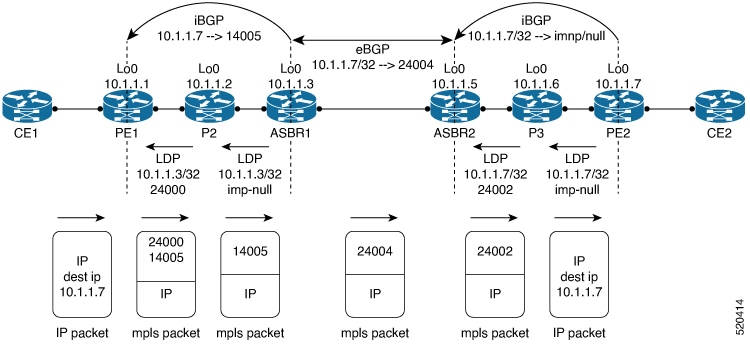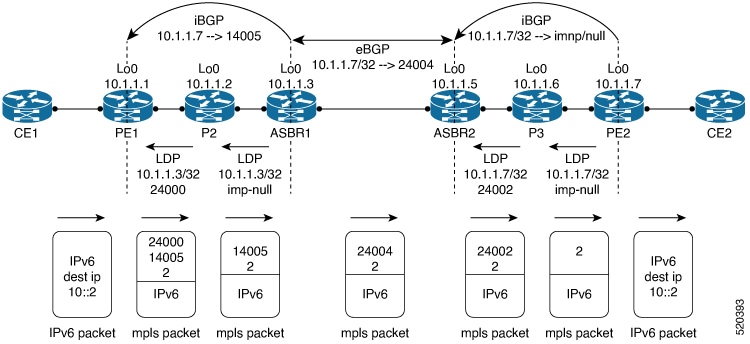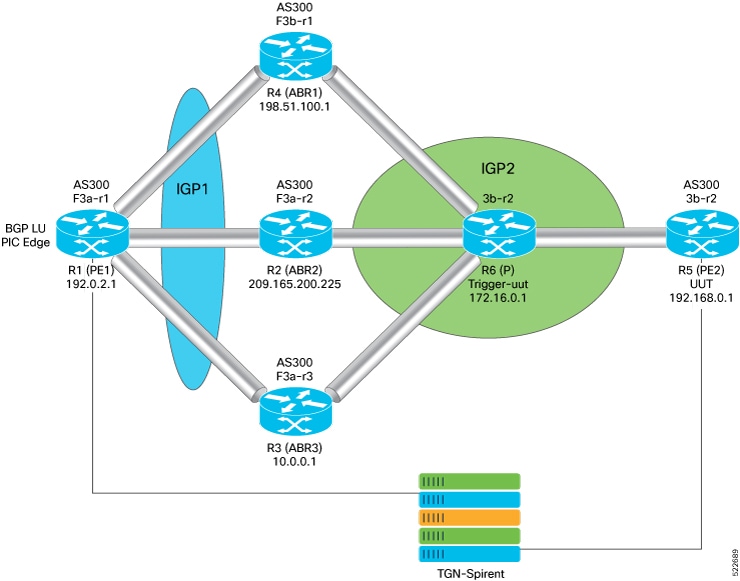BGP labeled unicast
BGP labeled unicast key components
The BGP labeled unicast is a routing feature that
-
provides MPLS transport between Provider Edge (PE) routers separated by multiple IGP boundaries or autonomous systems
-
uses autonomous system border routers (ASBRs) to advertise PE loopback prefixes and their MPLS label bindings via iBGP between area border routers (ABRs) and eBGP between ASBRs, and
-
supports multihop eBGP between PEs in different ASes to exchange VPN routes and enables services like 6PE over BGP LU connectivity.
-
PE routers are routers at the edge of a provider network that connect to customer networks.
-
ASBRs connect different autonomous systems.
-
iBGP and eBGP are internal and external Border Gateway Protocol sessions used for route exchange within and between ASes.
BGP labeled unicast overview
|
Feature Name |
Release |
Description |
|---|---|---|
|
BGP Labeled Unicast |
Release 25.4.1 |
Introduced in this release on: Fixed Systems (8010 [ASIC: A100], 8700 [ASIC: K100])(select variants only*) *This feature is supported on:
|
|
BGP Labeled Unicast |
Release 25.1.1 |
Introduced in this release on: Fixed Systems (8010 [ASIC: A100])(select variants only*) *This feature is supported on Cisco 8011-4G24Y4H-I routers. |
|
BGP Labeled Unicast |
Release 24.4.1 |
Introduced in this release on: Fixed Systems (8200 [ASIC: P100], 8700 [ASIC: P100, K100])(select variants only); Modular Systems (8800 [LC ASIC: P100])(select variants only*) This feature enables seamless MPLS transport between Provider Edge (PE) routers across multiple IGP boundaries or autonomous systems by utilizing Autonomous Systems Border Routers (ASBRs) to advertise loopback prefixes and MPLS label bindings through iBGP and eBGP. *This feature is supported on:
|
BGP labeled unicast, also known as unified MPLS, helps you scale MPLS transport across complex network topologies involving multiple IGP areas and AS boundaries. By using BGP LU, you reduce the scale of IGP labeled prefixes and adjacencies, which improves network efficiency.
To avoid unintended scale reduction on routers not configured for BGP LU, you must configure the hw-module command before enabling BGP LU. After configuring this command, you need to restart the router for the changes to take effect.
For example, you can run 6PE and other MPLS VPN services between PEs separated by multiple ASes or IGP areas, simplifying route advertisement and label distribution.
This approach helps you manage large-scale MPLS networks more effectively by lowering the overhead on IGP and BGP processes while maintaining connectivity and service capabilities.
Guidelines for BGP labeled unicast
To ensure proper configuration and compatibility, follow these guidelines and restrictions for the BGP LU feature:
-
Use only per-VRF label mode on Cisco 8000; other label modes are not supported.
-
Use Label Distribution Protocol (LDP) or Segment Routing (SR) for the transport underlay; do not use Traffic Engineering (TE).
-
Do not enable the BGP Prefix Independent Convergence (PIC) edge feature.
-
Do not configure L3VPN or 6VPE over BGP LU.
-
Enable the BGP Prefix Independent Convergence (PIC) core feature only if needed.
-
Do not use the deprecated label-allocation-mode command in IOS XR Release 7.4.1 or later; use the label mode command under the configured address-family instead.
-
Avoid using the deprecated label-allocation-mode command to ensure compatibility with current releases.
Features supported by BGP labeled unicast
BGP labeled unicast includes the following supported features:
-
BGP LU with inter-AS Option C
-
6PE over MPLS transport using LDP or SR
-
BGP PIC core
-
L3VPN and L2VPN services over BGP LU using LDP or SR transport
How MPLS connectivity for BGP labeled unicast across multiple OSPF areas works
In large service provider networks, MPLS with BGP labeled unicast enables scalable connectivity across multiple OSPF areas by using label switching and iBGP-based label distribution. This process is essential for connecting remote sites and maintaining efficient, reliable routing in complex environments.
Summary
Effective BGP labeled unicast implementation across diverse OSPF areas relies on the coordinated functions of these key components:
-
PE1 and PE2: Provider edge routers that establish connectivity across OSPF areas.
-
OSPF areas (OSPF1, OSPF2, OSPF3): Separate OSPF instances running in different areas to support routing.
-
Label Distribution Protocol (LDP ): Provides transport label switching between OSPF areas.
-
iBGP: Internal BGP used to advertise labels and loopback addresses between PE2 and PE1 via intermediate routers.
-
ASBR1 and ASBR2: Autonomous system border routers that assign and swap labels during packet forwarding.
-
P1, P2, P3: Intermediate routers in the MPLS network forwarding iBGP and MPLS traffic.
This coordinated interplay of edge, core, and routing protocols facilitates robust and scalable MPLS transport for BGP labeled unicast across disparate OSPF areas.
Workflow

These stages describe how the BGP labeled unicast (intra-autonomous aystem) control plane and data plane works:
-
Establishing iBGP connectivity
- Actor: PE2, intermediate routers (P3, ASBR2, P1, ASBR1, P2), PE1
- Action: PE2 sends iBGP updates to PE1 through the path P3 → ASBR2 → P1 → ASBR1 → P2. PE1 learns PE2’s loopback address to establish connectivity.
-
Label advertisement and allocation
- Actor: PE2, ASBR2, ASBR1, PE1
-
Actions:
- PE2 advertises its loopback address 10.1.1.7 with a BGP label (implicit null) via iBGP to ASBR2.
- ASBR2 assigns a local label 14003 and advertises it to ASBR1.
- ASBR1 assigns label 14005 and advertises it to PE1.
- PE1 learns the prefix and label 14005, with ASBR1 as the BGP next hop.
-
Packet forwarding from PE1 to PE2
- Actor: PE1, ASBR1, ASBR2
-
Actions:
- PE1 sends traffic to PE2 with two labels: the BGP-LU label 14005 and the transport LDP label 24000 on top.
- The transport LDP label carries the packet to ASBR1.
- ASBR1 swaps the BGP-LU label from 14005 to 14003, applies transport LDP label 24001, and forwards the packet to ASBR2.
- ASBR2 uses an implicit null BGP-LU label and pushes transport label 24002 to forward the packet to PE2.
Result
This process enables PE1 and PE2 to communicate across multiple OSPF areas using MPLS with label switching, ensuring efficient and scalable inter-area connectivity.
How inter-AS connectivity works using eBGP
Summary
The key components involved in the process are:
-
PE1 and PE2: Provider Edge routers serving as the source and destination for IP packets.
-
ASBR1 and ASBR2: Autonomous System Border Routers performing eBGP peering, label advertisement, allocation, and swapping.
-
LDP (Label Distribution Protocol): Used to signal transport labels across the MPLS path.
-
BGP-LU (BGP Labeled Unicast): Facilitates label route advertisement between routers across and within AS boundaries.
-
IGP (Interior Gateway Protocol): Supports local MPLS path computation where applicable.
This process enables reliable MPLS connectivity across multiple autonomous systems. eBGP connects ASBRs at AS boundaries for route and label exchange. By combining BGP-LU, LDP, and correct label operations, providers ensure efficient IP packet forwarding between PE routers over a multi-AS MPLS backbone. Understanding label allocation, advertisement, and swapping across ASBRs is key to inter-AS MPLS success.
Workflow

These stages describe how inter-AS connectivity using eBGP works:
-
Label advertisement by PE2
- Actor: PE2
- Action: PE2 advertises the BGP-LU label (implicit null) to ASBR2 via iBGP.
-
Label allocation and advertisement by ASBR2
- Actor: ASBR2
-
Actions:
- ASBR2 prefers the IGP MPLS path with LDP label 24002.
- It allocates a local label 24004 for loopback address 10.1.1.7.
- ASBR2 advertises label 24004 to ASBR1.
-
Label creation and advertisement by ASBR1
- Actor: ASBR1
-
Actions
- ASBR1 creates a local label 14005.
- It advertises label 14005 to PE1
-
Packet forwarding from PE1 to PE2
- Actor: PE1, ASBR1, ASBR2
-
Actions
- PE1 sends IP packets with BGP label 14005 and transport label 24000 to ASBR1.
- ASBR1 swaps the BGP-LU label 14005 to 24004.
- ASBR2 pushes the LDP label 24002 and forwards the packet to PE2.
Result
This process ensures that IP packets from PE1 are efficiently delivered to PE2 across autonomous system boundaries using eBGP and MPLS label switching, enabling robust and scalable inter-AS connectivity.
How MPLS connectivity with multihop eBGP between multiple ASes works
Summary
The key components involved in the process are:
-
PE1 router: Initiates label imposition on IPv6 packets and exchanges 6PE routes with PE2 using Multihop eBGP.
-
PE2 router: Advertises IPv6 prefixes with explicit null labels and performs IPv6 lookup to forward packets.
-
ASBR1 router: Swaps BGP Label Unicast (LU) labels and forwards packets between ASes.
-
ASBR2 router: Adds Label Distribution Protocol (LDP) labels and forwards packets toward PE2.
-
P3 router: Pops the top LDP label before delivering packets to PE2.
This process describes how PE1 and PE2 use MPLS with multihop eBGP across multiple ASes to enable seamless IPv6 forwarding, focusing on 6PE route exchange and the sequence of label operations.
Workflow

These stages describe how MPLS connectivity with multihop eBGP between multiple ASes works:
- Establishing a multihop eBGP session and exchanging routes: PE1 and PE2 establish a multihop eBGP session across multiple ASes to exchange 6PE routes with associated labels.
- Advertising IPv6 prefixes by PE2: PE2 advertises an IPv6 prefix (e.g., 10::2/128) with the 6PE label set to the IPv6 explicit null label.
- IPv6 packet arrival at PE1: An IPv6 packet destined for 10::2/128 arrives at PE1.
-
Label imposition at PE1:
The PE1 router imposes labels on the packet in the following order:
- First, the 6PE label with value 2 (IPv6 explicit null).
- Next, the BGP label 14005.
- Finally, the next-hop LDP label 14005 for the BGP LU next hop.
- Label swapping at ASBR1: ASBR1 receives the packet, swaps the BGP-LU label from 14005 to 24004, and forwards it to ASBR2.
- LDP label imposition by ASBR2: ASBR2 adds an LDP label on top of the 6PE label 2 and forwards the packet to P3.
- Label popping at P3: P3 pops the top LDP label so that PE2 receives the packet with only the 6PE explicit null label remaining.
- IPv6 lookup and forwarding at PE2: PE2 performs an IPv6 lookup on the packet and forwards it to the final destination.
Result
This process enables seamless IPv6 packet forwarding between PE routers across multiple ASes by leveraging MPLS with multihop eBGP and label stacking. The correct sequence of label imposition, swapping, and removal ensures that IPv6 traffic is efficiently routed and delivered end to end.
Configure BGP labeled unicast
Enable BGP LU to support labeled IPv6 unicast routing on your router.
BGP labeled unicast extends BGP to distribute labeled routes, allowing routers to forward IPv6 packets using MPLS labels. This capability is essential for scalable and flexible IPv6 routing with MPLS label switching.
Before you begin
-
Ensure you have administrative access to the router.
-
Confirm the router supports BGP-LU and the required hardware module features.
Follow these steps to configure BGP labeled unicast:
Procedure
|
Step 1 |
Enable the BGP-LU hardware profile. Example: |
|
Step 2 |
Restart the router to activate the BGP-LU hardware profile. |
|
Step 3 |
Enable the BGP-LU feature and configure the BGP router with IPv6 unicast address family settings to support labeled unicast routing. Example: |
|
Step 4 |
Configure a BGP neighbor with an IPv6 address, enabling the labeled-unicast address family and applying inbound and outbound route policies. Example: |
|
Step 5 |
Use the show running-config to verify the running configuration. Example: |
BGP labeled unicast is enabled on your router, supporting labeled IPv6 unicast routing with the specified neighbor, and the hardware profile is active.
What to do next
Restart the router after enabling the hardware module profile if you have not already done so to ensure all changes take effect.





 Feedback
Feedback